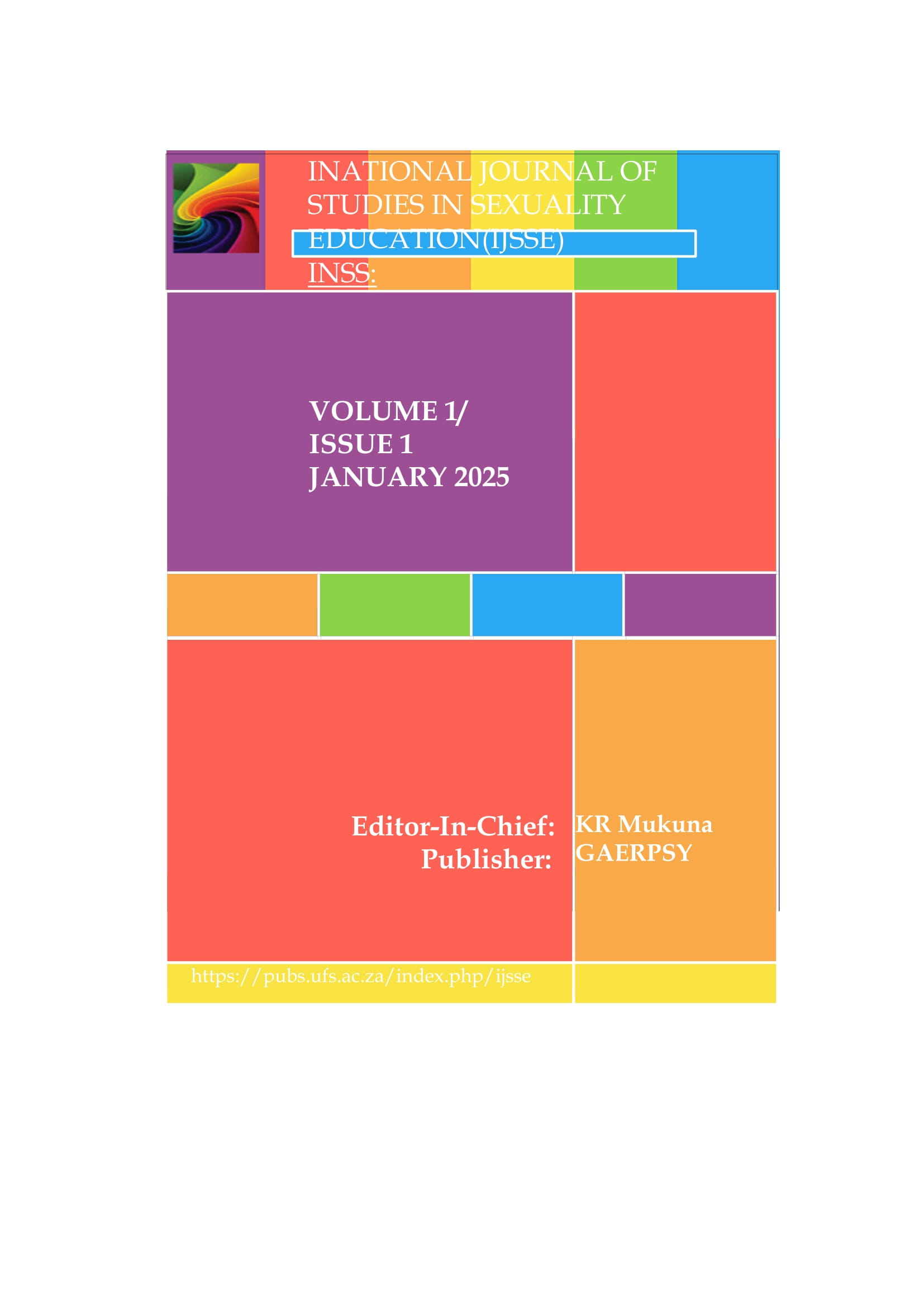Exploring experiences and challenges of LGBT learners facing at South African schools in the Sekhukhune district
DOI:
https://doi.org/10.38140/ijsse.v1i1.1436Keywords:
LGBT bullying, Grade 11 learners, Physical bullying, Emotional bullyingAbstract
This study investigates the experiences of LGBT learners regarding LGBT bullying in the Sekhukhune district. This study utilised a qualitative phenomenological study approach. It eomplyed semi-structured interviews as technique for data collection. Five LGBT learners were purposively selected from three secondary schools in the rural village of Sekhukhune, Limpopo province, South Africa. Their ages ranged from 14 to 17 year-old and faced continuous bullying at school and in his community, ultimately leading to his tragic death. The results showed that even minor instances of bullying is crucial to prevent them from escalating. This study recommends raising the awareness, dispel misconceptions, and educate communities and schools about LGBT issues. It gives all stakeholders a platform on how to eliminate and manage bullying in schools. This study is significant because it includes learners' perspectives, which are often overlooked in prior research.
References
Alase, A. (2017). The interpretative phenomenological analysis (IPA): A guide to a good qualitative research approach. International Journal of Education and Literacy Studies, 5(2), 9-19. http://dx.doi.org/10.7575/aiac.ijels.v.5n.2p.9
Al-Busaidi, Z. Q. (2008). Qualitative Research and Its Uses in Health Care. Sultan Qaboos University Medical Journal, 8(1), 11-19.
Al-Raqqad, H. K., Al-Bourini, E. S., Al Talahin, F. M., & Aranki, R. M. E. (2017). The Impact of School Bullying on Students' Academic Achievement from Teachers Point of View. International Education Studies, 10(6), 44-50. https://doi.org/10.5539/ies.v10n6p44
American Psychological Association (APA). (2020). Bullying and school climate. Retrieved from https://www.apa.org/ed/schools/primer/bullying
Best, J. W., & Kahn, J. V. (2003). Descriptive studies: Assessment, evaluation, and research. Research in education, 9, 114-158.
Bhana, A. (2012). Homophobic bullying in South African schools: A review of the literature. South African Journal of Education, 32(2) 227-241.
Bohm, A. S., Del Duca, S., Elliott, E., Holako, S., & Tanner, A. (2016). Challenges Facing LGBT Youth. Georgetown Journal of Gender and the Law, 17(1), 125-174.
Braun, V., & Clarke, V. (2006). Using thematic analysis in psychology. Qualitative research in psychology, 3(2), 77-101. https://doi.org/10.1191/1478088706qp063oa
Burrell, G., & Morgan, G. (1979). Sociological paradigms and organizational analysis. Farnham, UK: Ashgate Publishing https://doi.org/10.4324/9781315609751
Campbell, C. (2023). GBTQ+community. Source: Salem Press Encyclopedia.
Campbell, S., Greenwood, M., Prior, S., Shearer, T., Walkem, K., Young, S., ... & Walker, K. (2020). Purposive sampling: complex or simple? Research case examples. Journal of research in Nursing, 25(8), 652-661. https://doi.org/10.1177/1744987120927206
Collingridge, D. S., & Gantt, E. E. (2008). The quality of qualitative research. American journal of medical quality, 23(5), 389-395. https://doi.org/10.1177/1062860608320646
Creswell, J. W., & Poth, C. N. (2016). Qualitative Inquiry and Research Design: Choosing among five approaches. Thousand Oaks Sage publications.
Creswell, J. W., Cheryl, N., & Poth, C. N. (2016). First steps in research (2nd ed.). Braamfontein: Van schaik publishers.
Crotty, M. (1998). The foundations of social research: meaning and perspective in the research process. London: Sage. https://doi.org/10.4324/9781003115700
Dale, J. C., Hallas, D., & Spratling, R. (2019). Critiquing research evidence for use in practice: Revisited. Journal of Pediatric Health Care, 33(3), 342-346. https://doi.org/10.1016/j.pedhc.2019.01.005
De Barros, L. (2022). Bullied gay 14-year-old takes his own life. Mamba online.com. Retrieved from https://www.mambaonline.com/2022/06/10/bullied-gay-14-year-old-takes-his-own-life
De Wet, C. (2005). The nature and extent of bullying in Free State secondary schools. South African Journal of Education, 25(2), 82-88.
DeJonckheere, M., & Vaughn, L. M. (2019). Semistructured interviewing in primary care research: a balance of relationship and rigour. Family medicine and community health, 7(2), e000057. https://doi.org/10.1136/fmch-2018-000057
DePalma, R., & Atkinson, E. (2009). ‘No outsiders’: Moving beyond a discourse of tolerance to challenge heteronormativity in primary schools. British Educational Research Journal, 35(6), 837-855. https://doi.org/doi/pdf/10.1080/01411920802688705
Department of Basic Education (DBE) (2012). Challenging homophobic bullying in schools. Pretoria: Government Printers.
Doty, R. L., & King, E. A. (2018). Social constructionism and LGBT bullying: A theoretical framework. Journal of LGBT Youth, 15(1), 4-25.
Earnshaw, V. A., Reisner, S. L., Juvonen, J., Hatzenbuehler, M. L., Perrotti, J., & Schuster, M. A. (2017). LGBTQ bullying: translating research to action in pediatrics. Pediatrics, 140(4), e20170432. https://doi.org/10.1542/peds.2017-0432
Etikan, I., Musa, S. A., & Alkassim, R. S. (2016). Comparison of Convenience Sampling and Purposive Sampling. American Journal of Theoretical and Applied Statistics, 5(1), 1-4. https://doi.org/10.11648/j.ajtas.20160501.11
Finlay, L. (2011) Phenomenology for psychotherapists: researching the lived world. Wiley-Blackwell, USA
Flick, U. (2006). An introduction to qualitative research (3rd ed.). London: Sage Publications.
Francis, D. (2019). ‘Keeping it straight’what do South African queer youth say they need from sexuality education?. Journal of Youth Studies, 22(6), 772-790. https://doi.org/10.1080/13676261.2018.1539223
Gergen, K. J. (1985). Social constructionist inquiry: Context and implications. The social construction of the person, 3-18.
Gill, P., Stewart, K., Treasure, E., & Chadwick, B. (2008). Methods of Data Collection in Qualitative Research: Interviews and focus groups. British Dental Journal, 204(6), 291-295. https://doi.org/10.1038/bdj.2008.192
Hatzenbuehler, M. L., Rutherford, C., McKetta, S., Prins, S. J., & Keyes, K. M. (2020). Structural stigma and all-cause mortality among sexual minorities: Differences by sexual behavior? Social Science & Medicine, 244, 112463. https://doi.org/10.1016/j.socscimed.2019.112463
Henriksen, M. G, Englander. M., & Noordgaard. J. (2021). Method of data collection psychopathology: the role of semi-structured, phenomenological interviews. Journal of phenomenology and the cognitive science, 21(3), 9-3. https://doi.org/10.1007/s11097-021-09730-5tha
Henriksson, C. (2012). Hermeneutic Phenomenology and Pedagogical Practice. In N. Friesen, C. Henriksson, & T. Saevi (eds.), Hermeneutic Phenomenology in Education Method and Practice (pp. 119). Rotterdam: Sense Publishers.
Herek, G. M. (2007). Confronting Sexual Stigma and Prejudice: Theory and Practice. Journal of Social Issues, 63(4), 905-925. https://doi.org/10.1111/j.1540-4560.2007.00544.x
Human Rights Watch. (2017). Just Let Us Be: Discrimination Against LGBT Students in the Philippines. New York, NY: Human Rights Watch.
Jacobs, G., van Lieshout, F., Borg, M., & Ness, O. (2017). Being a person?centred researcher: principles and methods for doing research in a person?centred way. Person?centred healthcare research, 51-60.
Jones, T. (2019). South African contributions to LGBTI education issues, Sex Education, 19(4), 455-471. https://doi.org/10.1080/14681811.2018.1535969
Kallio, H. Pietil?, A. M., Johnson, M., & Kangasniemi, M. (2016). Systematic methodological review: Developing a framework for a qualitative semi-structured interview guide. Journal of Advanced Nursing, 72(12), 2954-2965.
Kosciw, J. G., Greytak, E. A., Giga, N. M., Villenas, C., & Danischewski, D. J. (2016). The 2015 National School Climate Survey: The Experiences of Lesbian, Gay, Bisexual, Transgender, and Queer Youth in Our Nation’s Schools ((pp. 1-179). New York, NY: GLSEN.
Lake, L., Tomlinson, M., & Kleintjes, S. (2022). Reflections From The South African Child Gauge 2021/22 Gauging Progress and Setting an Agenda for Child and Adolescent Mental Health. Mental Health Matters, 9(4), 21-23.
Makunika, N. (2020). A sociological analysis on the survival strategies of illegal urban transport operators in Harare Zimbabwe. International Journal of Social Science, 9(1), 45-55. https://doi.org/10.30954/2249-6637.01.2020.6
Maunder, R. E., & Crafter, S. (2018). School bullying from a sociocultural perspective. Aggression and violent behavior, 38, 13-20. https://doi.org/10.1016/j.avb.2017.10.010
Maxwell, J. A. (2010). Using numbers in qualitative research. Qualitative inquiry, 16(6), 475-482. https://doi.org/10.1177/1077800410364740
Meeusen, C., & Dhont, k. (2015). Parent-child similarity in common and specific components of prejudice: The role of ideological attitudes and political discussion. European journal of personality, 29(1), 585–598. https://doi.org/10.1002/per.2011
Merriam, S. B. (2009). Qualitative research: A guide to design and implementation. San Francisco, CA: Jossey-Bass.
Moser, A., & Korstjens, I. (2018). Series: Practical guidance to qualitative research. Part 3: Sampling, data collection, and analysis. European Journal of General Practice, 24(1), 9-18. https://doi.org/10.1080/13814788.2017.1375091
Munhall, P. L. (2013). Interpretive phenomenology. In Routledge international handbook of qualitative nursing research (pp. 145-161). London: Routledge.
Newcomer, K. E., Hatry, H. P., & Wholey, J. S. (2015). Conducting semi-structured interviews. Handbook of practical program evaluation, 12(2), 492-570. https://doi.org/10.1002/9781119171386
Nieuwenhuis, J. (2007). Qualitative research designs and data gathering techniques. In K. Maree (ed.), First steps in research, (pp. 70-90). Pretoria: Van Schaik
Olweus, D. (2010). Understanding and researching bullying: Some critical issues. In S. R. Jimerson, S. M. Swearer, & D. L. Espelage (Eds.), Handbook of bullying in schools: An international perspective (pp. 9–33). London: Routledge.
Patrón, O. E. (2021). Precarious Familismo among Latinas/os/xs: Toward a critical theoretical framework centering queer communities. Journal of Social and Personal Relationships, 38(3), 1085-1102. https://doi.org/10.1177/0265407520971049
Patterson, C. J. (2017). Parents' sexual orientation and children's development. Child Development Perspectives, 11(1), 45-49. https://doi.org/10.1111/cdep.12207
Poteat, V. P., Sinclair, K. O., DiGiovanni, C. D., Koenig, B. W., & Russell S. T. (2013). Gay–straight alliances are associated with student health: a multischool comparison of LGBTQ and heterosexual youth. Journal of Research on Adolescence, 23(2), 319–330. https://doi.org/10.1111/j.1532-7795.2012.00832.x
Reddy, S., Chen, D., & Manning, C. D. (2019). Coqa: A conversational question answering challenge. Transactions of the Association for Computational Linguistics, 7, 249-266. https://doi.org/10.1162/tacl_a_00266
Reeves, S., Albert, M., Kuper, A., & Hodges, B. D. (2008). Why Use Theories in Qualitative Research? British Medical Journal, 337, 631-634. https://doi.org/10.1016/10.1136/bmj.a949
Republic of South Africa (RSA). (1996). Constitution of the Republic of South Africa (Act 108 of 1996). Government Gazette No. 25799. Constitution of the Republic of South Africa [No. 108 of 1996]
Republic of South Africa (RSA). (1996). The South African Schools Act, Act 84 of 1996. Pretoria: Government Printer.
Rivers, I., & Smith, P. K. (1994). Types of bullying behaviour and their correlates. Aggressive Behavior, 20(5), 359–368. https://doi.org/10.1002/1098-2337(1994)20:5<359::AID-AB2480200503>3.0.CO;2-J
Robertson, M. (2020). Review of Growing up Queer: Kids and the remaking of LGBTQ identity. Social forces,98(4), 1–2, https://doi.org/10.1093/sf/soz118
Robinson, B. A., Mu, F., Webb, J. M., & Stone, A. L. (2024). Intersectional Social Support: Gender, Race, and LGBTQ Youth Friendships. Society and Mental Health, 0(0). https://doi.org/10.1177/21568693241266960
Salmivalli, C. (2010). Bullying and the peer group: A review. Aggression and violent behavior, 15(2), 112-120. https://doi.org/10.1016/j.avb.2009.08.007
Salmons, J. (2017). Using social media in data collection: Designing studies with the qualitative e-research framework. In L. Sloan & A. Quan-Haase (eds.), The SAGE handbook of social media research methods, (pp. 177-197). London: SAGE Publications. https://doi.org/10.4135/9781473983847.n12
Saunder, M. (2015). Understanding research philosophies and approaches. Chapter 4, 13(4), 122-161.
Sikhakhane, H. N., Muthukrishna, N., & Martin, M. (2018). The geographies of bullying in a secondary school context. South African Journal of Education, 38(1), Art. #1589, 11 pages. https://doi.org/10.15700/saje.v38ns1a1589
Smith, J. A., Flower, P., & Larkin, M. (2009). Interpretative phenomenological analysis: theory, method and research. London: Sage Publishing.
South African Human Rights Commission (SAHRC). (2017). Investigative hearing report: National hearing on unfair discrimination in school admissions. https://www.sahrc.org.za
Thanh, N. C., & Thanh, T. L. (2015). The Interconnection between Interpretivist Paradigm and Qualitative Methods in Education. American Journal of Education Science. 1(2), 24-27. http://www.aiscience.org/journal/ajes
Theodore, P. S., & Chiasson, J. (2021). Evolving strategies to counter school bullying of gender and sexually diverse students. In M. C. Lytle & R. A. Sprott (Eds.), Supporting gender identity and sexual orientation diversity in K-12 schools (pp. 71–96). American Psychological Association. https://doi.org/10.1037/0000211-005
Thornberg, R. (2015). The social dynamics of school bullying: The necessary dialogue between the blind men around the elephant and the possible meeting point at the social-ecological square. Confero: Essays on Education, Philosophy and Politics, 3(2), 161-203. DOI:10.3384/confero.2001-4562.1506245
Thornberg, R., & Charmaz, K. (2014). Grounded theory and theoretical coding. The SAGE handbook of qualitative data analysis, 5, 153-169. https://doi.org/10.1080/10.4135/9781446282243.n11
Thornberg, R., & Delby, H. (2019). How do secondary school students explain bullying?. Educational Research, 61(2), 142-160. https://doi.org/10.1080/00131881.2019.1600376
Troop-Gordon, W., Chambless, K., & Brandt, T. (2021). Peer victimization and well-being as a function of same-ethnicity classmates and classroom social norms: Revisiting person × environment mismatch theory. Developmental Psychology, 57(12), 2050–2066. https://doi.org/10.1037/dev0001161
Tuffour, I. (2017). A critical overview of interpretative phenomenological analysis: A contemporary qualitative research approach. Journal of healthcare communications, 2(4), 1-5. https://doi.org/10.4172/2472-1654.100093
United Nations Educational, Scientific and Cultural Organization (UNESCO). (2016). Out in the Open. Paris: UNESCO.
Van Meter, P., & Garner, J. (2005). The Promise and Practice of Learner-Generated Drawing: Literature review and synthesis. Educational Psychology Review, 17(4), 285-325. https://doi.org/10.1080/10.1007/s10648-005-8136-3
Welsh, E. (2002, May). Dealing with data: Using NVivo in the qualitative data analysis process. In Forum qualitative sozialforschung/Forum: qualitative social research, 3(2), Art. 26. https://doi.org/10.17169/fqs-3.2.865
Worthington, M. (2013). Differences between phenomenological research and a basic qualitative research design.
Published
How to Cite
Issue
Section
Copyright (c) 2025 Mweli Patrick, Mmabatho Mphahlele

This work is licensed under a Creative Commons Attribution-NonCommercial-NoDerivatives 4.0 International License.









